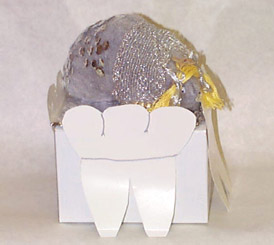Silver By Noelle Buckles |
|
| Silver is an important element in today’s world. It is a
white, lustrous, metallic element that has the chemical symbol Ag. Its atomic number is
forty- seven and its atomic weight is 107.868. Silver conducts heat and electricity better
than any other metal, and other than gold, it is the most ductile of all metals. It is
harder than gold, but softer than copper. Silver melts at a high 962 degrees Celsius and
boils at a scorching 2,212 degrees Celsius. How is silver classified? Silver is usually categorized as a noble medal, precious metal, or transition metal. It is a noble metal because it does not oxidize readily when heated, nor does it dissolve in most inorganic acids. Since silver is high in value, it is considered a precious metal. Silver is considered a transition metal because of its position on the periodic table. Does silver have any isotopes? Of course silver has isotopes. Silver consists of two stable isotopes called silver-107 and silver-109. Is silver active chemically? Silver is not very active. It is insoluble in dilute acids, but dissolves in concentrated nitric acid. Silver does not react with oxygen or water at ordinary temperatures, but it does react with ozone, and sulfides such as hydrogen sulfide. Silver ranks about 66th among elements in natural abundance in crustal rocks. Pure silver is also found associated with pure gold in the form of an alloy called electrum. It is usually found combined with other elements in minerals and ores. Silver also occurs as a constituent of lead, copper, and zinc ores, and half the world’s production of silver is obtained as a by-product in producing such ores. Silver in Europe is almost always obtained from the lead sulfide ore called galena. When thinking of silver, the first thing that probably comes to your mind is sterling silver, used to make jewelry, and fancy silverware. Don’t be fooled when a merchant tells you that their product is made of pure silver. The truth is, sterling silver is not one hundred percent silver. Instead, it is 92.5 percent silver and 7.5 percent copper. While most people associate silver with jewelry, only ten percent of the world’s silver is used to make jewelry, silver plates, and sterling ware. This is a small percentage compared to the forty percent that is used for photography. The light sensitive properties of silver compounds work well for photography. Photographic film is composed of acetates upon which a thin gelatin layer, the emulsion, is spread. The emulsion contains a silver salt called a halide, as well as organic and inorganic sensitizing compounds. There are three types of silver compounds used in photography. There is silver iodide for fast films, silver bromide for slower films and fast printing papers, and silver chloride for most printing paper. How do these silver compounds help photography? When light falls upon them, the silver compounds are photo oxidized. Photo oxidization happens when electrons are released from the halide ions, and combine with the silver ions, forming elemental silver atoms suspended in the gelatin emulsion. Then, the film is placed in a developer, which continues the oxidation process in the salt crystals already affected by light. There is no impact on the unaffected crystals. After this happens, the film is placed into a sodium thiosulfate bath to stop the oxidation process, leaving an image from which a print can be made. Silver is definitely needed for film processing, but what are some of this elements other uses?
A common use in the past for silver was to make coins. After the year 1964, silver was eliminated from dimes and quarters and reduced to forty percent for halfdollars. Today, only six percent of the world’s silver is used for coinage. Another use for silver is the silvering of mirrors. Silver is used to coat smooth glass surfaces by vaporization of the metal or by precipitation from a solution. Today though, aluminum has largely replaced silver in this process. Other uses for silver include the use in switches, printed circuits, long-lasting batteries, bearing alloys for airplanes, diesel engines, and some automobiles. When alloyed with copper, silver is used for welding. In it’s colloidal form, silver serves as a catalyst in the manufacturing of certain alcohol. When silver is alloyed with cesium, it is employed in photocells. When it is in a form of silver iodide, it is used to seed clouds for weather modification purposes. Finally, we come to the silver "mole"ar. We know that a molar is a back tooth that dentists sometimes fill with silver when there is a cavity. But what about the "mole"? Biologists may argue that a mole is a furry animal, however chemists say that it represents a measurement in chemistry. A mole in chemistry is a base unit of the International System of Units. A mole is defined as the amount of a substance that contains as many elementary particles, such as atoms or molecules, as the number of atoms in twelve grams of carbon-12. This number, which other substances are measure is approximately 6.02 x 1023. This number is known as the Avogadro’s number. A mole is an amount of any substance that weighs, in grams, as much as the numerically equivalent atomic weight of that substance. A mole of silver is a specific measure of the element, but a silver "mole"ar is something else altogether! |
